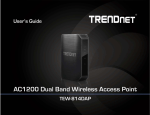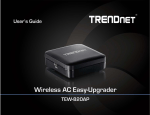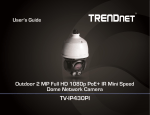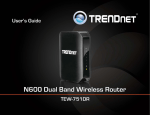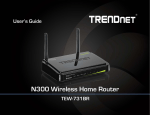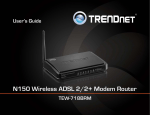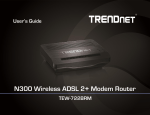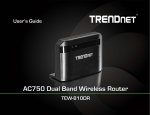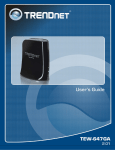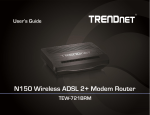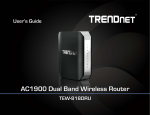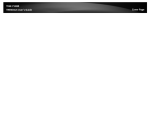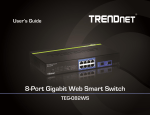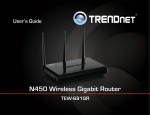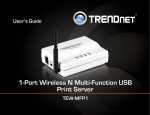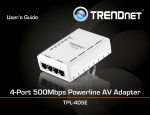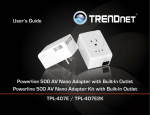Download test 3 - TRENDnet
Transcript
TRENDnet User’s Guide
Cover Page
TRENDnet User’s Guide
Table of Contents
Product Overview ...........................................................................3
Package Contents .......................................................................................................... 3
Features ......................................................................................................................... 3
Product Hardware Features........................................................................................... 4
Basic Media Bridge and Router Setup ..............................................5
Application Diagram ...................................................................................................... 5
Getting Started ...............................................................................6
Installation and Login..................................................................................................... 6
Access to the Management Interface ............................................................................ 8
Using the Wizard ........................................................................................................... 8
Wi-Fi Protected Setup (WPS) ....................................................................................... 10
Network........................................................................................ 11
Table of contents
How to choose the type of security for your wireless network .................................. 15
Secure your wireless network ..................................................................................... 16
Connect devices to your Media Bridge ........................................................................ 18
Steps to improve wireless connectivity ....................................................................... 18
Media Bridge Maintenance & Monitoring ..................................... 19
Reset your Media Bridge to factory defaults ............................................................... 19
Media Bridge Default Settings ..................................................................................... 20
Backup and restore your media bridge configuration settings ................................... 20
Reboot your media bridge ........................................................................................... 21
Media Bridge Management Page Structure ................................... 22
Technical Specifications ................................................................ 23
Troubleshooting ........................................................................... 24
Appendix ...................................................................................... 25
LAN Setting .................................................................................................................. 11
Wireless ........................................................................................ 11
Basic Wireless Setting .................................................................................................. 11
Connect wireless devices using WPS ........................................................................... 12
Link Status.................................................................................................................... 13
Site Survey ................................................................................................................... 13
QoS, Quality of Service ................................................................................................ 13
Administrator ............................................................................... 14
System Management ................................................................................................... 14
Upload Firmware ......................................................................................................... 14
Settings Management.................................................................................................. 14
Status ........................................................................................................................... 15
Wireless Networking and Security ................................................. 15
© Copyright 2013 TRENDnet. All Rights Reserved.
2
TEW-800MB
TRENDnet User’s Guide
Product Overview
Security
Encrypted Wireless
Wireless encryption up to WPA2
Performance
Next Generation Wireless AC**
802.11ac* provides uninterrupted HD video streaming in a busy connected home
Dual Band
Connect to an 867 Mbps Wireless AC or a 300 Mbps Wireless N network
Gigabit Ports
TEW-800MB v1.0R
Package Contents
In addition to your media bridge, the package includes:
•
•
•
•
CD-ROM (Quick Installation and User’s Guide)
Multi-Language Quick Installation Guide
Network cable/Ethernet Cable (1.5m / 5ft.)
Power Adapter (12V, 2A)
If any package contents are missing or damaged, please contact the retail store, online
retailer, or reseller/distributor from which the product was purchased.
Features
Connect devices to the four Gigabit ports
Backward Compatible
Compatible with older Wireless G devices
*For maximum performance of up to 867 Mbps use with a 867 Mbps 802.11ac wireless
router
**Maximum wireless signal rates are referenced from IEEE 802.11 theoretical
specifications. Actual data throughput and coverage will vary depending on
interference, network traffic, building materials and other conditions
The AC1200 Dual Band Wireless Media Bridge, model TEW-800MB, connects up to four
devices around your entertainment center to a revolutionary Wireless AC network.
Connect a network enabled TV, media player, gaming console, and receiver to the
Gigabit ports. Wireless AC easily handles multiple HD streams simultaneously.
Ease of Use
One Touch Connection
Securely connect to a router at the touch of the Wi-Fi Protected Setup (WPS) button
© Copyright 2013 TRENDnet. All Rights Reserved.
3
TEW-800MB
TRENDnet User’s Guide
Product Hardware Features
•
Power Port – Connect the included power adapter to your media bridge’s
power port and then to an available power outlet.
•
On/Off Power Switch (EU Only) – Push the media bridge’s On/Off power
switch to turn your media bridge “On” (Inner position) or “Off” (Outer
position).
•
Reset Button (Located on Bottom) – Press and hold this button for 10 seconds
to reset the media bridge.
Rear View
*In WPS mode, the TEW-800MB may connect to your router on the default 2.4GHz
band. Please refer to the Manual setting of the Basic Wireless Setting section, for the
5GHz band choice.
WPS Button
Gigabit LAN
Ports 1-4 (Black)
On/Off Power Switch
(EU only)
Power Port
Reset Button (Located on Bottom)
•
WPS Button (Wi-Fi Protected Setup)* – Push and hold this button for 5
seconds to activate WPS. The Power LED will blink when WPS is activated.
•
Gigabit LAN Ports 1-4 – Connect Ethernet cables (also called network cables)
from your media bridge’s LAN ports to your wired network devices.
© Copyright 2013 TRENDnet. All Rights Reserved.
4
TEW-800MB
TRENDnet User’s Guide
Front View
indicators will blink green while data is transmitted or received through your
media bridge’s Gigabit LAN ports.
Power/WPS LED: The indicator will turn solid green when your media bridge is
powered on. Otherwise if this LED indicator is off, there is no power to your
media bridge. The indicator will also blink when WPS is activated. The LED will
stop blinking and will remain solid green once the WPS process is completed.
Basic Media Bridge and Router Setup
5GHz Wireless LED
2.4GHz Wireless LED
Application Diagram
LAN Ports 1-4 LEDs
Power/WPS LED
5GHz Wireless (Link/Activity) LED: The indicator will turn solid green when 5GHz
wireless is enabled on your media bridge. The indicator will blink when data is
transmitted or received from 5GHz wireless devices connected to your media
bridge.
2.4GHz Wireless (Link/Activity) LED: The indicator will turn solid green when
2.4GHz wireless is enabled on your media bridge. The indicator will blink when
data is transmitted or received from 2.4GHz wireless devices connected to your
media bridge.
LAN Ports 1-4 (Link/Activity) LED: These LED indicators will turn solid green when
Gigabit LAN ports 1-4 (Black) are physically connected to your wired network
devices (which are turned on) with a network or Ethernet cable. These LED
The media bridge is connected by Ethernet or network cable with your client devices such as your
TV, DVD player, or game console; connected wirelessly with your router either on the 2.4GHz
(default) or 5GHz band.
The router is installed near the modem (typically supplied by your ISP “Internet Service Provider”)
and is physically connected via Ethernet or network cable from the router’s Internet port to the
modem’s network port. 2.4GHz wireless signals are broadcasted from the router to wireless
clients such as laptops (with wireless capability) and the less congested 5GHz wireless signals are
broadcasted from the router to other wireless client devices such as the media bridge, TEW800MB, which connects with your TV, game console, or DVD player, thereby providing Internet
access for all network ready devices.
© Copyright 2013 TRENDnet. All Rights Reserved.
5
TEW-800MB
TRENDnet User’s Guide
a. Have one network (LAN) port from the router connect with the media bridge;
have one network port from the media bridge connect with the computer.
Getting Started
Installation and Login
Note: Do not connect/install the TEW-800MB to your network until instructed to do so.
Make sure your network adapter settings on PC are set to obtain an IP address
automatically and the computer name is not a member of domain but workgroup*, or
refer to the Troubleshooting section.
b. Have one network port from the media bridge and one network port from the
computer connect with network (LAN) ports on the router respectively.
*Make sure your computer name is a member of a workgroup, not a member of a domain. Under Windows 7,
go to the Control Panel, then System, then Change Settings; under the computer name tab of the system
properties, select Change in order to set the computer name between the Domain and the Workgroup. In case
your computer name is already under a domain name - In order to have the Computer Name/Domain
Changes, you will have to enter the name and password of an account with permission to remove the
computer from the domain. If you have issues doing so, please consult the IT person who made the domain
name settings on your computer.
1.
2.
Connect the Power Adapter to the TEW-800MB and then to a power outlet (EU
versions will have a power button on the back. Push the power button to the
“On” position.). Wait 30 seconds for the TEW-800MB to boot up.
3.
Plug in the power adapter and verify the Power & LAN port LEDs are lit.
As illustrated above, connect one end of the provided RJ-45 network cable to one
of the TEW-800MB’s network ports. Connect the other end of the cable to your
computer’s network port**; move on to the next step.
**Other options (make sure all devices are powered on and network cables are
connected correctly):
© Copyright 2013 TRENDnet. All Rights Reserved.
6
TRENDnet User’s Guide
TEW-800MB
4. Open your web browser and enter http://TEW-800MB/ or http://192.168.10.110/
into the address bar to access the wizard and configuration menu whenever you require.
5. Enter your User Name and Password, select your preferred language, and then click
Login. You can find the unique password on a sticker on the front of TEW-800MB and on
the label on the bottom of TEW-800MB.
User Name: admin
Password: XXXXXXXX
Note: User name and Password are case sensitive.
© Copyright 2013 TRENDnet. All Rights Reserved.
7
TEW-800MB
TRENDnet User’s Guide
Access to the Management Interface
Using the Wizard
The wizard will automatically appear after you successfully log in. If you wish not to
continue with the wizard and access to the management interface directly, click Cancel.
The Wizard will automatically appear after you successfully log in. Click Wizard if the
Wizard does not automatically appear.
Click Next
Then, the management interface will appear.
© Copyright 2013 TRENDnet. All Rights Reserved.
8
TEW-800MB
TRENDnet User’s Guide
Select Manual Setup and then click Next.
Click Scan
Select the Wireless Network Name for your wireless network and then click Select.
1.
Click Next
Select the security mode on your router; then enter your router’s Passphrase/Password
and click Next.
2.
Click Apply
© Copyright 2013 TRENDnet. All Rights Reserved.
9
TEW-800MB
TRENDnet User’s Guide
3.
Click OK and wait while changes are being applied. Setup is complete. Place
the TEW-800MB in your desired location. Please refer to the “Steps to improve
wireless connectivity” section on page 18 for your location placement.
Wi-Fi Protected Setup (WPS)
1.
Power up the TEW-800MB (On/Off power switch, EU only); wait until the
power LED on the front of the unit lights up.
Press the WPS button on your router for 5 sec, then the WPS button on the
TEW-800MB for another 5 sec.
After the connection between the TEW-800MB and your router is successful,
the IP address of the TEW-800MB will change to a different IP from the default,
192.168.10.110. To find out the IP assigned to the TEW-800MB from your
router, please check the DHCP client (device) list on your router and then type
in the assigned IP of the media bridge from your router in the browser to
access to the management interface of the media bridge. You may type in the
http://tew-800mb in your browser to access to the management interface of
the media bridge.
2.
The power button will start blinking. Installation is complete when the power
LED turns solid green. Note: With the WPS installation method, the TEW800MB adopts your router's password settings and wireless encryption.
In WPS mode, the TEW-800MB may connect to your router on the default
2.4GHz band. Please refer to the Manual setting of the Basic Wireless Setting
section for the 5GHz band choice.
© Copyright 2013 TRENDnet. All Rights Reserved.
10
TEW-800MB
TRENDnet User’s Guide
Network
LAN Setting
Subnet Mask
The subnet mask of the local area network; it should be the same as your
router has.
Default Gateway
The IP address of the router on the local area network.
Wireless
Basic Wireless Setting
LAN Connection Type
Choose "Static IP (fixed IP)" if your router does not support DHCP or if for any
other reason you need to assign a fixed address to the media bridge. In this
case, you must also configure the following fields.
IP Address
It’s the IP address of this Media Bridge on the local area network. Assign any
unused IP address in the range of IP addresses available from your network. For
example, 192.168.10.110 is the default. If you chose the DHCP client setting:
After the connection between the TEW-800MB and your router is successful,
the IP address of the TEW-800MB will change to a different IP from the default,
192.168.10.110. To find out the IP assigned to the TEW-800MB from your
router, please check the DHCP client (device) list on your router and then type
in the assigned IP of the media bridge from your router in the browser to
access to the management interface of the media bridge. You may type in the
http://tew-800mb in your browser to access to the management interface of
the media bridge.
You can choose Wi-Fi Protected Setup™ (WPS) or Manual setup.
In WPS mode, the TEW-800MB may connect to your router on the default 2.4GHz band.
Under Manual setup, you can choose a 2.4GHz or 5GHz Wi-Fi connection by entering the
SSID and security key of your router, then click Save Settings.
2.4 GHz 802.11 B/G/N mixed mode
This wireless mode works in the 2.4GHz frequency range and will only allow the use of
wireless B/G/N client devices to connect and access the TEW-800MB, at 11Mbps for
wireless B, 54Mbps for wireless G, and up to 150Mbps transmitting/300Mbps receiving
for wireless N.
© Copyright 2013 TRENDnet. All Rights Reserved.
11
TEW-800MB
TRENDnet User’s Guide
5GHz 802.11 A/N/AC** mixed mode
This wireless mode allows the TEW-8000MB to connect only to devices on the 5GHz
wireless frequency. The highest data rate supported in this mode is 867Mbps*.
However, the wireless router or access point will need to have a similar 867Mbps
feature.
WPS (Wi-Fi Protected Setup) is a feature that makes it easy to connect devices to your
wireless network. If your wireless devices support WPS, you can use this feature to
easily add wireless devices to your network.
Note: You will not be able to use WPS if your router’s SSID Broadcast setting is disabled
or if you are using WEP security.
*For maximum performance of up to 867 Mbps use with an 867 Mbps 802.11ac wireless router.
There are two methods the WPS feature can easily connect your wireless devices to
your network.
**Maximum wireless signal rates are referenced from IEEE 802.11 theoretical specifications. Actual data
throughput and coverage will vary depending on interference, network traffic, building materials and other
conditions
• Push Button Configuration (PBC) method
Under Wi-Fi Protected Setup™ (WPS), you can choose the PBC (Push Button
Configuration) or PIN settings.
In WPS mode, the TEW-800MB may connect to your router on the default 2.4GHz band.
Please refer to the Manual setting of the Basic Wireless Setting section, for the 5GHz
band choice.
Connecting with WPS
- (RECOMMENDED) Hardware Push Button method – with external WPS buttons
located on your router and on your media bridge
- WPS Software/Virtual Push Button - located in the media bridge’s management page
• PIN (Personal Identification Number) Method - located in the media bridge’s
management page
Note: Refer to your wireless device documentation for details on the operation of
WPS.
Recommended Hardware Push Button (PBC) Method
• Note: It is recommended that a wireless key (passphrase or password) is created
before connecting clients using the PBC method. If no wireless key is defined when
connecting via PBC, the router will automatically create an encryption key that is 64
characters long. This 64 character key will then have to be used if you have to connect
computers to the router using the traditional connection method.
To add a wireless device to your network, simply push the WPS button on the wireless
device you are connecting (consult client device User’s Guide for length of time), then
push and hold the WPS button located on your router for 5 seconds and release it. A
blue LED on your router WPS button will flash indicating that the WPS setup process has
been activated on your router. (See “Product Hardware Features” on page 5)
For connecting additional WPS supported devices, repeat this process for each
additional device.
© Copyright 2013 TRENDnet. All Rights Reserved.
12
TEW-800MB
TRENDnet User’s Guide
Link Status
The Status page shows the settings and current operation status of the Station.
QoS, Quality of Service
Site Survey
Use the Site Survey tool to search for wireless networks around the TEW-800MB bridge.
Click on the Scan button to search for wireless network to join.
Click Refresh to search for the wireless networks around; then select the wireless
network in your choice; then click Connect.
WMM Support Enable / Disable
WMM® Quality of Service (QoS) technology prioritizes gaming, Internet calls, and video
streams.
No Acknowledgement Enable / Disable
To turn off the prioritization of ACK packets
Enter the passphrase in your selected wireless network; click Connect.
© Copyright 2013 TRENDnet. All Rights Reserved.
13
TEW-800MB
TRENDnet User’s Guide
Administrator
System Management
You can configure the administrator password. The device URL (host name) can be
entered in place of the IP address you choose and the default is http://192.168.10.110
or http://tew-800mb/ , to access this device.
Settings Management
You can save system settings by exporting them, as a backup, to a configuration file;
restore them by importing the file, or reset them to factory default.
Export Settings
Upload Firmware
Navigate to the folder on your computer where the unzipped firmware file (.bin) is
located and select it for firmware upgrade.
This option allows you to export and then save the media bridge's configuration to a file
on your computer as a backup. Be sure to save the configuration before performing a
firmware upgrade.
Import Settings
Use this option to restore previously saved media bridge configuration settings.
Click Apply. If prompted, click Yes or OK to start the firmware upgrading process.
Load Factory Defaults
This option restores all configuration settings back to the settings that were in effect at
the time the media bridge was shipped from the factory. Any settings that have not
been saved will be lost. If you want to save your media bridge configuration settings,
use the Export Settings option above.
System Reboot
This restarts the media bridge. It is useful for restarting when you are not near the
device.
© Copyright 2013 TRENDnet. All Rights Reserved.
14
TRENDnet User’s Guide
Status
You can check system information and network configurations on this page.
Wireless Networking and Security
How to choose the type of security for your wireless network
Setting up wireless security is very important. Leaving your wireless network open and
unsecure could expose your entire network and personal files to outsiders. TRENDnet
recommends reading through this entire section and setting up wireless security on your
router and the media bridge.
There are a few different wireless security types supported in wireless networking each
having its own characteristics which may be more suitable for your wireless network
taking into consideration compatibility, performance, as well as the security strength
along with using older wireless networking hardware (also called legacy hardware).
It is strongly recommended to enable wireless security to prevent unwanted users from
accessing your network and network resources (personal documents, media, etc.).
In general, it is recommended that you choose the security type with the highest
strength and performance supported by the wireless computers and devices in your
network. Please review the security types to determine which one you should use for
your network.
TEW-800MB
Wireless Encryption Types
• WEP: Legacy encryption method supported by older 802.11b/g hardware. This is
the oldest and least secure type of wireless encryption. It is generally not
recommended to use this encryption standard, however if you have old 802.11 b or
802.11g wireless adapters or computers with old embedded wireless cards(wireless
clients), you may have to set your router to WEP to allow the old adapters to
connect to the router.
Note: This encryption standard will limit connection speeds to 54Mbps.
• WPA: This encryption is significantly more robust than the WEP technology. Much
of the older 802.11g hardware was been upgraded (with firmware/driver upgrades)
to support this encryption standard. Total wireless speeds under this encryption
type however are limited to 54Mbps.
• WPA-Auto: This setting provides the router with the ability to detect wireless
devices using either WPA or WPA2 encryption. Your wireless network will
automatically change the encryption setting based on the first wireless device
connected. For example, if the first wireless client that connects to your wireless
network uses WPA encryption your wireless network will use WPA encryption. Only
when all wireless clients disconnect to the network and a wireless client with WPA2
encryption connects your wireless network will then change to WPA2 encryption.
Note: WPA2 encryption supports 802.11n speeds and WPA encryption will limit
your connection speeds to 54Mbps
• WPA2: This is the most secure wireless encryption available today, similar to WPA
encryption but more robust. This encryption standard also supports the highest
connection speeds. TRENDnet recommends setting your router to this encryption
standard. If you find that one of your wireless network devices does not support
WPA2 encryption, then set your router to either WPA or WPA-Auto encryption.
Note: Check the specifications of your wireless network adapters and wireless
appliances to verify the highest level of encryption supported. Below is brief
comparison chart of the wireless security types and the recommended
configuration depending on which type you choose for your wireless network.
© Copyright 2013 TRENDnet. All Rights Reserved.
15
TEW-800MB
TRENDnet User’s Guide
Security Standard
Compatible
Wireless
Standards
Highest
Performance
Under This
Setting
Encryption
Strength
Additional
Options
Recommended
Configuration
WEP
WPA
IEEE 802.11a/b/g
(802.11n devices
will operate at
802.11g to connect
using this
standard)
IEEE 802.11a/b/g/n
Up to 54Mbps
Up to 54Mbps
Up to 450Mbps (11n)
and up to 1.3Gbps
(11ac)*
Low
Open System or
Shared Key,
HEX or ASCII,
Different key sizes
Medium
High
TKIP or AES,
Preshared Key or
RADIUS
TKIP or AES,
Preshared Key or
RADIUS
TKIP
Preshared Key
8-63 characters
AES
Preshared Key
8-63 characters
IEEE 802.11a/b/g
(802.11n devices
will operate at
802.11g to connect
using this standard)
Open System ASCII
13 characters
WPA2
Secure your wireless network
Wireless (2.4GHz or 5GHz)> Basic Wireless Settings> Wireless Security
After you have determined which security type to use for your wireless network (see
“How to choose the security type for your wireless network” on page 15), you can set up
wireless security.
1. Log into your router management page (see “Installation and Login” on page 6).
2. Click on the wireless band Wireless (2.4GHz or 5GHz) you would like to configure.
*Dependent on the maximum 802.11n/ac data rate supported by the device (150Mbps,
300Mbps, 450Mbps, 867Mbps, or 1.3Gbps)
3. Click on the Security Mode drop-down list to select your wireless security type.
© Copyright 2013 TRENDnet. All Rights Reserved.
16
TEW-800MB
TRENDnet User’s Guide
Selecting WEP-OPEN, WEP-SHARED:
If selecting WEP (Wired Equivalent Privacy), please review the WEP settings to configure
and click Apply to save the changes.
Note: WPS functionality is not available when using WEP.
In the Security Mode drop-down list, select WEP-OPEN or WEP-SHARED.
Note: It is recommended to use WEP-OPEN because it is known to be more secure than
Shared Key.
•
Click here to display - Typically, the password characters are masked for
security purposes. This link displays actual characters of the currently assigned
password for your reference.
Selecting WPA-Personal, or WPA2-Personal (WPA2-Personal recommended):
In the Security Mode drop-down list, make selection and enter passphrase.
• WPA passphrase: Enter the passphrase.
o This is the password or key that is used to connect your computer to the router
wirelessly; now you have the TEW-800MB connect to your router as wireless
client.
Note: 8-63 alphanumeric characters (a,b,C,?,*, /,1,2, etc.)
• Current Network Key - You can define 1 key.
• Network Key 1
o This is where you enter the WEP key needed for a computer to
connect to the router wirelessly
o You can define 1 passwords or 1 key.
o When connecting to the router, the TEW-800MB must match both the
password and the Key number.
WEP Key Format
HEX
ASCII
Character set
0-9 & A-F, a-f only
Alphanumeric (a,b,C,?,*, /,1,2, etc.)
64-bit key length
10 characters
5 characters
128-bit key length
26 characters
13 characters
Note: It is recommended to use 128-bit format because it is more secure to use a
key that consists of more characters.
© Copyright 2013 TRENDnet. All Rights Reserved.
17
TEW-800MB
TRENDnet User’s Guide
Connect devices to your Media Bridge
A variety of network devices can connect to your wireless network such as:
•
Gaming Consoles
•
Internet enabled TVs
•
Network media players
•
IP cameras
Steps to improve wireless connectivity
There are a number of factors that can impact the range of wireless devices. Follow
these tips to help improve your wireless connectivity:
1.
Each device may have its own software utility for searching and connecting to available
wireless networks, therefore, you must refer to the User’s Manual/Guide of your client
device to determine how to search and connect to this router’s wireless network.
2.
Keep the number of obstructions to a minimum. Each obstruction can reduce
the range of a wireless device. Position the wireless devices, the router and the
media bridge, in a manner that will minimize the amount of obstructions
between them.
a.
For the widest coverage area, install your router near the center of
your home, and near the ceiling, if possible.
b.
Avoid placing the router or the media bridge on or near metal objects
(such as file cabinets and metal furniture), reflective surfaces (such as
glass or mirrors), and masonry walls.
c.
Any obstruction can weaken the wireless signal (even non-metallic
objects), so the fewer obstructions between the router and the media
bridge, the better.
d.
Place the router or the media bridge in a location away from other
electronics, motors, and fluorescent lighting.
e.
Many environmental variables can affect the router and the media
bridge’s performance, so if your wireless signal is weak, place the
router and the media bridge in several locations and test the signal
strength to determine the ideal position.
Building materials can have a large impact on your wireless signal. In an indoor
environment, try to position the wireless devices so that the signal passes
through less dense material such as dry wall. Dense materials like metal, solid
wood, glass or even furniture may block or degrade the signal.
© Copyright 2013 TRENDnet. All Rights Reserved.
18
TEW-800MB
TRENDnet User’s Guide
3.
Antenna orientation can also have a large impact on your wireless signal. Use
the wireless adapter or the media bridge’s site survey tool to determine the
best antenna orientation for your wireless devices.
4.
Interference from devices that produce RF (radio frequency) noise can also
impact your signal. Position your wireless devices away from anything that
generates RF noise, such as microwaves, radios and baby monitors.
If possible, upgrade wireless network interfaces (such as wireless cards in computers)
from older wireless standards to 802.11n or 802.11ac. If a wirelessly networked device
uses an older standard, the performance of the entire wireless network may be slower.
If you are still experiencing low or no signal consider repositioning the wireless devices,
installing additional access points or wireless extenders.
Media Bridge Maintenance & Monitoring
Reset your Media Bridge to factory defaults
Administrator > Settings Management
You may want to reset your media bridge to factory defaults if you are encountering
difficulties with your router and have attempted all other troubleshooting. Before you
reset your media bridge to defaults, if possible, you should backup your media bridge
configuration first; restore configuration after firm upgrade or reset, see “Backup and
restore your media bridge configuration settings” on page 20.
There are two methods that can be used to reset your media bridge to factory defaults.
• Reset Button – Located on the bottom panel of your media bridge, see “Product
Hardware Features” on page 4. Use this method if you are encountering
difficulties with accessing your router management page.
OR
• Settings Management Page
1. Log into your media bridge management page (see “Installation and Login” on page
6).
2. Click on Administrator and click on Settings Management.
3. Under Load Factory Default, click Load Default. When prompted to confirm this
action, click OK.
4. To restore your media bridge configuration: refer to the next page.
© Copyright 2013 TRENDnet. All Rights Reserved.
19
TEW-800MB
TRENDnet User’s Guide
Media Bridge Default Settings
Backup and restore your media bridge configuration settings
Administrator > Settings Management
Administrator User Name
admin
Administrator Password
Please refer sticker or device label
Media Bridge IP Address
192.168.10.110
Subnet Mask
255.255.255.0
Wireless 2.4GHz
Enabled
Wireless 5Ghz
Disabled
WPS default
Wireless 2.4GHz
You may have added many customized settings to your router and in the case that you
need to reset your media bridge to default, all your customized settings would be lost
and would require you to manually reconfigure all of your router settings instead of
simply restoring from a backed up media bridge configuration file.
To backup your media bridge configuration:
1. Log into your media bridge management page (see “Installation and Login” on page
6).
2. Click on Administrator and click on Settings Management.
3. Under Export Settings section, click Export.
4. Depending on your web browser settings, you may be prompted to save a file (specify
the location) or the file may be downloaded automatically to the web browser
settings default download folder. (Default Filename: .cfg)
To restore your media bridge configuration:
1. Log into your media bridge management page (see “Installation and Login” on page
6).
2. Click on Administrator and click on Settings Management.
3. Under Import Settings, next to Settings file location, depending on your web
browser, click on Browse or Choose File.
4. A separate file navigation window should open.
5. Select the router configuration file to restore and click Import. (Default Filename:
.cfg). If prompted, click Yes or OK.
© Copyright 2013 TRENDnet. All Rights Reserved.
20
TRENDnet User’s Guide
TEW-800MB
6. Wait for the media bridge to restore settings.
Reboot your media bridge
Administrator > Settings Management
You may want to restart your router if you are encountering difficulties with your router
and have attempted all other troubleshooting.
There are two methods that can be used to restart your media bridge.
• Turn the media bridge off for 10 seconds using the media bridge On/Off switch
(EU version only) located on the rear panel of your media bridge or disconnecting
the power port, see “Product Hardware Features” on page 5.
Use this method if you are encountering difficulties with accessing your media
bridge management page. This is also known as a hard reboot or power cycle.
OR
• Media bridge, Settings Management Page – This is also known as a soft reboot
or restart.
1. Log into your router management page (see “Installation and Login” on page 6).
2. Click on Administrator and click on Settings Management.
3. Under System Reboot section, click Reboot.
© Copyright 2013 TRENDnet. All Rights Reserved.
21
TEW-800MB
TRENDnet User’s Guide
Media Bridge Management Page Structure
Wireless
Wizard
•
•
Welcome
Configuration
o
o
•
Basic Wireless Setting
o
Manual Setup
o Wireless Network
o Select SSID
o
2.4GHz
o Select Security
o
5GHz
o
Network Name, SSID
Wi-Fi Protected Setup™
o PBC, Push Button Configuration
o Wireless Security
o PIN
•
Manual
** In the WPS mode, the TEW-800MB may connect to
your router on the default 2.4GHz band. Please refer to
the Manual setting of the Basic Wireless Setting
section, for the 5GHz band choice.
o
Complete
Wi-Fi Protected Setup™**
o PBC, Push Button Configuration
o PIN
Network
•
LAN (Local Area Network) Setting
o
LAN Interface Setting
o DHCP Client
o Static IP
o
DHCP Setting
•
Link Status
•
Site Survey
•
QoS, Quality of Service
Administrator
•
•
•
•
Management
o
Administrator Settings
o
Device URL settings
Upload Firmware
Settings Management
o
Export Settings
o
Import settings
o
Load Factory Default
o
System Reboot
Status
© Copyright 2013 TRENDnet. All Rights Reserved.
22
TEW-800MB
TRENDnet User’s Guide
Technical Specifications
Hardware
Standards
Wired: IEEE 802.3 (10Base-T), IEEE 802.3u (100Base-TX), IEEE 802.3ab
(1000Base-T)
Wireless: IEEE 802.11ac (draft 2.0), IEEE 802.11n, IEEE 802.11g, IEEE
802.11b, 802.11a
LAN
4 x 10/100/1000 Mbps Auto-MDIX
WPS Button
Wi-Fi Protected Setup (WPS) connects with other WPS compliant
devices
Reset Button
Reset unit back to factory default (press and hold for 10 seconds)
Quality of Service
WMM
Connection Type
Dynamic IP, Static (fixed) IP, IPv6 pass-thru
Management
Web-based configuration, firmware upgrade, backup / restore
configuration via web browser, reboot through web GUI, access device
thru URL, web based setup wizard
/ Monitoring
Web Browser support
Internet Explorer7.0 or above, Firefox 2.0 or above, Chrome, Opera,
Safari
LED Indicator
Power/WPS, LAN 1-4, 2.4 GHz Wireless, 5 GHz Wireless
Power Adapter
5 GHz: 2 x 2 dBi PIFA internal
Modulation
802.11b: up to 11 Mbps
Data Rate
Dimension (L x W x H)
45 x 120 x 164 mm (1.8 x 4.7 x 6.5 in)
Weight
295 g (10.4 oz)
Operation: 0°~ 40°C (32°F~ 104°F)
Storage: -20°~ 60°C (-4°F~140 °F)
Humidity
Max. 85% (non-condensing)
Certifications
CE, FCC
802.11g: up to 54 Mbps
802.11n: up to 300 Mbps (for both 2.4 & 5 GHz)
802.11ac: up to 867 Mbps
Security
64/128-bit WEP (for 11g/b), WPA/WPA2-PSK, WPS: support PIN and PBC
802.11a: 20 dBm (max.) (FCC) & 17 dBm (max.) (CE) @ HT40
802.11b: 18 dBm (max.) @ CCK
Output Power
802.11g: 17 dBm (max.) @ HT40
802.11n (2.4GHz): 17 dBm (max.) @ HT40
802.11n (5GHz): 20 dBm (max.) (FCC) & 17 dBm (max.) (CE) @ HT40
802.11ac: 20 dBm (max.) (FCC) & 18 dBm (max.) (CE) @ VHT80
802.11a: -68 dBm (typical) @ 54 Mbps
Receiving Sensitivity
802.11b: -84 dBm (typical) @ 11 Mpbs
802.11g: -72 dBm (typical) @ 54 Mbps
802.11n: -68 dBm (typical) @ 300 Mbps (for 2.4 & 5 GHz)
802.11ac: -55 dBm (typical) @ 867 Mbps
Output: 12 V DC, 2 A external power adapter
12 watts (max.)
CCK, DQPSK, DBPSK, OFDM, BPSK, QPSK, 16/64/256-QAM
802.11a: up to 54 Mbps
Input: 100 ~ 240 V, 50~60 Hz, 0.8 A
Power Consumption
Temperature
2.4 GHz: 2 x 2 dBi PIFA internal
Channels
2.4 GHz: 1~11 (FCC), 1~13 (ETSI)
5 GHz: 36, 40, 44, 48, 149, 153, 157, 161, 165 (FCC) 36, 40, 44, 48 (ETSI)
*Maximum wireless signal rates are referenced from IEEE 802.11 theoretical specifications. Actual
data throughput and coverage will vary depending on interference, network traffic, building
materials and other conditions.
Wireless
2.4 GHz: 2.412~2.462 (FCC) and 2.412~2.472 (ETSI)
Frequency
5 GHz: 5.180 ~ 5.240 / 5.745~5.825 GHz (FCC) and 5.180 ~ 5.240 GHz
(ETSI)
Antenna
2 internal antenna; 4 path
© Copyright 2013 TRENDnet. All Rights Reserved.
23
TRENDnet User’s Guide
Troubleshooting
Q: I typed http://192.168.10.110 or http://tew-800mb in my Internet Browser Address
Bar, but an error message says “The page cannot be displayed.” How can I access the
media bridge management page?
Answer:
1. Check your hardware settings again. See “Installation and Login” on page 6.
2. Make sure your computer is connected to one of the media bridge’s LAN ports with
power on; the power and the network port lights are lit.
3. Make sure your computer network adapter TCP/IP settings are set to Obtain an IP
address automatically or DHCP (see the steps below).
4. Make sure your computer name is a member of a workgroup, not a member of
domain. Under Windows 7, go to the Control Panel, then System, then Change
Settings; under the computer name tab of the system properties, select the Change,
in order to set the computer name between the Domain and the Workgroup. In case
your computer name is already under a domain name, in order to have the
Computer Name/Domain Changes, you will have to enter the name and password of
an account with permission to remove the computer from the domain. If you have
issues doing so, please consult the IT who made the domain name setting on your
computer.
5. Press on the factory reset button on the bottom panel of the media bridge for 15
seconds; then release.
Windows 7
a. Go into the Control Panel, click Network and Sharing Center.
b. Click Change Adapter Settings, right-click the Local Area Connection icon.
c. Then click Properties and click Internet Protocol Version 4 (TCP/IPv4).
d. Then click Obtain an IP address automatically and click OK.
Windows Vista
a. Go into the Control Panel, click Network and Internet.
b. Click Manage Network Connections, right-click the Local Area Connection
icon and click Properties.
c. Click Internet Protocol Version (TCP/IPv4) and then click Properties.
d. Then click Obtain an IP address automatically and click OK.
Windows XP/2000
a. Go into the Control Panel, double-click the Network Connections icon
b. Right-click the Local Area Connection icon and the click Properties.
c. Click Internet Protocol (TCP/IP) and click Properties.
TEW-800MB
d. Then click Obtain an IP address automatically and click OK.
Note: If you are experiencing difficulties, please contact your computer or operating
system manufacturer for assistance.
Q: The Wizard does not appear when I access the media bridge. What should I do?
Answer:
1. Click on Wizard on the left hand side.
2. Near the top of the browser, “Pop-up blocked” message may appear. Right click on
the message and select Always Allow Pop-ups from This Site.
3. Disable your browser's pop up blocker.
Q: I went through the Wizard, but I cannot get onto the Internet. What should I do?
Answer:
1. Verify that you can get onto the Internet with a direct connection into your modem
(meaning plug your computer directly to the modem and verify that your single
computer (without the help of the router) can access the Internet).
2. Power cycle your modem and router. Unplug the power to the modem and router.
Wait 30 seconds, and then reconnect the power to the modem. Wait for the modem
to fully boot up, and then reconnect the power to the router.
3. Contact your ISP and verify all the information that you have in regards to your
Internet connection settings is correct.
Q: I cannot connect wirelessly to the router. What should I do?
Answer:
1. Double check that the WLAN light on the router is lit.
2. Power cycle the router. Unplug the power to the router. Wait 15 seconds, then plug
the power back in to the router.
3. Contact the manufacturer of your wireless network adapter and make sure the
wireless network adapter is configured with the proper SSID.
4. To verify whether or not wireless is enabled, login to the router management page,
click on Wireless.
5. Please see “Steps to improve wireless connectivity” on page 18 if you continue to
have wireless connectivity problems.
© Copyright 2013 TRENDnet. All Rights Reserved.
24
TEW-800MB
TRENDnet User’s Guide
Appendix
How to find your IP address?
Note: Please note that although the following procedures provided to follow for your
operating system on configuring your network settings can be used as general
guidelines, however, it is strongly recommended that you consult your computer or
operating system manufacturer directly for assistance on the proper procedure for
configuring network settings.
Command Prompt Method
Windows 2000/XP/Vista/7
1. On your keyboard, press Windows Logo+R keys simultaneously to bring up the Run
dialog box.
2. In the dialog box, type cmd to bring up the command prompt.
3. In the command prompt, type ipconfig /all to display your IP address settings.
MAC OS X
1. Navigate to your Applications folder and open Utilities.
2. Double-click on Terminal to launch the command prompt.
3. In the command prompt, type ipconfig getifaddr <en0 or en1> to display the wired
or wireless IP address settings.
Note: en0 is typically the wired Ethernet and en1 is typically the wireless Airport
interface.
Graphical Method
MAC OS 10.6/10.5
1. From the Apple menu, select System Preferences.
2. In System Preferences, from the View menu, select Network.
3. In the Network preference window, click a network port (e.g., Ethernet, AirPort,
modem). If you are connected, you'll see your IP address settings under "Status:"
MAC OS 10.4
1. From the Apple menu, select Location, and then Network Preferences.
2. In the Network Preference window, next to "Show:", select Network Status. You'll see
your network status and your IP address settings displayed.
Note: If you are experiencing difficulties, please contact your computer or operating
system manufacturer for assistance.
How to configure your network settings to obtain an IP address automatically or use
DHCP?
Note: Please note that although the following procedures provided to follow for your
operating system on configuring your network settings can be used as general
guidelines, however, it is strongly recommended that you consult your computer or
operating system manufacturer directly for assistance on the proper procedure for
configuring network settings.
Windows 7
a. Go into the Control Panel, click Network and Sharing Center.
b. Click Change Adapter Settings, right-click the Local Area Connection icon.
c. Then click Properties and click Internet Protocol Version 4 (TCP/IPv4).
d. Then click Obtain an IP address automatically and click OK.
Windows Vista
a. Go into the Control Panel, click Network and Internet.
b. Click Manage Network Connections, right-click the Local Area Connection
icon and click Properties.
c. Click Internet Protocol Version (TCP/IPv4) and then click Properties.
d. Then click Obtain an IP address automatically and click OK.
Windows XP/2000
a. Go into the Control Panel, double-click the Network Connections icon
b. Right-click the Local Area Connection icon and the click Properties.
c. Click Internet Protocol (TCP/IP) and click Properties.
d. Then click Obtain an IP address automatically and click OK.
MAC OS 10.4/10.5/10.6
a. From the Apple, drop-down list, select System Preferences.
b. Click the Network icon.
c. From the Location drop-down list, select Automatic.
d. Select and view your Ethernet connection.
In MAC OS 10.4, from the Show drop-down list, select Built-in
Ethernet and select the TCP/IP tab.
In MAC OS 10.5/10.6, in the left column, select Ethernet.
© Copyright 2013 TRENDnet. All Rights Reserved.
25
TEW-800MB
TRENDnet User’s Guide
e. Configure TCP/IP to use DHCP.
In MAC 10.4, from the Configure IPv4, drop-down list, select Using
DHCP and click the Apply Now button.
In MAC 10.5, from the Configure drop-down list, select Using DHCP
and click the Apply button.
In MAC 10.6, from the Configure drop-down list, select Using DHCP
and click the Apply button.
f. Restart your computer.
Note: If you are experiencing difficulties, please contact your computer or operating
system manufacturer for assistance.
How to find your MAC address?
In Windows 2000/XP/Vista/7,
Your computer MAC addresses are also displayed in this window, however, you can type
getmac –v to display the MAC addresses only.
In MAC OS 10.4,
1. Apple Menu > System Preferences > Network
2. From the Show menu, select Built-in Ethernet.
3. On the Ethernet tab, the Ethernet ID is your MAC Address.
In MAC OS 10.5/10.6,
1. Apple Menu > System Preferences > Network
2. Select Ethernet from the list on the left.
3. Click the Advanced button.
3. On the Ethernet tab, the Ethernet ID is your MAC Address.
How to connect to a wireless network using the built-in Windows utility?
Note: Please note that although the following procedures provided to follow for your
operating system on configuring your network settings can be used as general
guidelines, however, it is strongly recommended that you consult your computer or
operating system manufacturer directly for assistance on the proper procedure for
connecting to a wireless network using the built-in utility.
Windows 7
1. Open Connect to a Network by clicking the network icon (
area.
or
) in the notification
2. In the list of available wireless networks, click the wireless network you would like to
connect to, then click Connect.
4. You may be prompted to enter a security key in order to connect to the network.
5. Enter in the security key corresponding to the wireless network, and click OK.
Windows Vista
1. Open Connect to a Network by clicking the Start Button.
To.
and then click Connect
2. In the Show list, click Wireless.
3. In the list of available wireless networks, click the wireless network you would like to
connect to, then click Connect.
4. You may be prompted to enter a security key in order to connect to the network.
5. Enter in the security key corresponding to the wireless network, and click OK.
Windows XP
1. Right-click the network icon in the notification area, then click View Available
Wireless Networks.
2. In Connect to a Network, under Available Networks, click the wireless network you
would like to connect to.
3. You may be prompted to enter a security key in order to connect to the network.
4. Enter in the security key corresponding to the wireless network, and click Connect.
© Copyright 2013 TRENDnet. All Rights Reserved.
26
TEW-800MB
TRENDnet User’s Guide
Federal Communication Commission Interference Statement
Europe – EU Declaration of Conformity
This equipment has been tested and found to comply with the limits for a Class B digital
device, pursuant to Part 15 of the FCC Rules. These limits are designed to provide
reasonable protection against harmful interference in a residential installation. This
equipment generates uses and can radiate radio frequency energy and, if not installed and
used in accordance with the instructions, may cause harmful interference to radio
communications. However, there is no guarantee that interference will not occur in a
particular installation. If this equipment does cause harmful interference to radio or
television reception, which can be determined by turning the equipment off and on, the user
is encouraged to try to correct the interference by one of the following measures:
This device complies with the essential requirements of the R&TTE Directive 1999/5/EC,
2006/95/EC and 2009/125/EC.
Regulation (EC) No. 1275/2008
Regulation (EC) No. 278/2009
EN60950-1 : 2006+A11 : 2009
Reorient or relocate the receiving antenna.
Increase the separation between the equipment and receiver.
Connect the equipment into an outlet on a circuit different from that to which the receiver is
connected.
Consult the dealer or an experienced radio/TV technician for help.
FCC Caution: Any changes or modifications not expressly approved by the party responsible
for compliance could void the user's authority to operate this equipment.
This device complies with Part 15 of the FCC Rules. Operation is subject to the following two
conditions: (1) This device may not cause harmful interference, and (2) this device must
accept any interference received, including interference that may cause undesired
operation.
IMPORTANT NOTE:
FCC Radiation Exposure Statement:
This equipment complies with FCC radiation exposure limits set forth for an uncontrolled
environment. This equipment should be installed and operated with minimum distance
20cm between the radiator & your body.
This transmitter must not be co-located or operating in conjunction with any other antenna
or transmitter.
The availability of some specific channels and/or operational frequency bands are country
dependent and are firmware programmed at the factory to match the intended destination.
The firmware setting is not accessible by the end user.
RoHS
This product is RoHS compliant.
Safety of Information Technology Equipment
EN 62311 : 2008
Product standard to demonstrate the compliance of radio base stations and fixed terminal
stations for wireless telecommunication systems with the basic restrictions or the reference
levels related to human exposure to radio frequency electromagnetic fields (110MHz - 40
GHz) - General public
EN 300 328 V1.7.1 : (2006-10) Class B
Electromagnetic compatibility and Radio spectrum Matters (ERM); Wideband Transmission
systems; Data transmission equipment operating in the 2,4 GHz ISM band and using spread
spectrum modulation techniques; Harmonized EN covering essential requirements under
article 3.2 of the R&TTE Directive
EN 301 489-1 V1.9.2 : (2011-09)
Electromagnetic compatibility and Radio Spectrum Matters (ERM); ElectroMagnetic
Compatibility (EMC) standard for radio equipment and services; Part 1: Common technical
requirements
EN 301 489-17 V2.2.1 : (2012-09)
Electromagnetic compatibility and Radio spectrum Matters (ERM); ElectroMagnetic
Compatibility (EMC) standard for radio equipment; Part 17: Specific conditions for 2,4 GHz
wideband transmission systems, 5 GHz high performance RLAN equipment and 5,8 GHz
Broadband Data Transmitting Systems
EN 301 893 V1.6.1 : (2011-11)
Broadband Radio Access Networks (BRAN);5 GHz high performance RLAN;Harmonized EN
covering the essential requirements of article 3.2 of the R&TTE Directive
This device is a 2.4/5G GHz wideband transmission system (transceiver), intended for use in
all EU member states and EFTA countries, except in France and Italy where restrictive use
applies.
In Italy the end-user should apply for a license at the national spectrum authorities in order
to obtain authorization to use the device for setting up outdoor radio links and/or for
supplying public access to telecommunications and/or network services.
This device may not be used for setting up outdoor radio links in France and in some areas
the RF output power may be limited to 10 mW EIRP in the frequency range of 2454 – 2483.5
MHz. For detailed information the end-user should contact the national spectrum authority
in France.
© Copyright 2013 TRENDnet. All Rights Reserved.
27
TEW-800MB
TRENDnet User’s Guide
Česky [Czech]
Dansk [Danish]
Deutsch
[German]
TRENDnet tímto prohlašuje, že tento TEW-800MB je ve shodě se
základními požadavky a dalšími příslušnými ustanoveními směrnice
1999/5/ES, 2006/95/ES, a 2009/125/ES.
Undertegnede TRENDnet erklærer herved, at følgende udstyr TEW800MB overholder de væsentlige krav og øvrige relevante krav i
direktiv 1999/5/EF, 2006/95/EF, og 2009/125/EF.
Hiermit erklärt TRENDnet, dass sich das Gerät TEW-800MB in
Übereinstimmung mit den grundlegenden Anforderungen und den
übrigen einschlägigen Bestimmungen der Richtlinie 1999/5/EG,
2006/95/EG und 2009/125/EG befindet.
Eesti [Estonian]
Käesolevaga kinnitab TRENDnet seadme TEW-800MB vastavust
direktiivi 1999/5/EÜ, 2006/95/EÜ ja 2009/125/EÜ põhinõuetele ja
nimetatud direktiivist tulenevatele teistele asjakohastele sätetele.
English
Hereby, TRENDnet, declares that this TEW-800MB is in compliance
with the essential requirements and other relevant provisions of
Directive 1999/5/EC, 2006/95/EC, and 2009/125/EC.
Español
[Spanish]
Por medio de la presente TRENDnet declara que el TEW-800MB
cumple con los requisitos esenciales y cualesquiera otras
disposiciones aplicables o exigibles de la Directiva 1999/5/CE,
2006/95/CE, 2009/125/CE y.
Ελληνική
[Greek]
ΜΕ ΤΗΝ ΠΑΡΟΥΣΑTRENDnet ΔΗΛΩΝΕΙ ΟΤΙTEW800MBΣΥΜΜΟΡΦΩΝΕΤΑΙ ΠΡΟΣ ΤΙΣ ΟΥΣΙΩΔΕΙΣ ΑΠΑΙΤΗΣΕΙΣ ΚΑΙ ΤΙΣ
ΛΟΙΠΕΣ ΣΧΕΤΙΚΕΣ ΔΙΑΤΑΞΕΙΣ ΤΗΣ ΟΔΗΓΙΑΣ 1999/5/ΕΚ, 2006/95/ΕΚ,
2009/125/ΕΚ και.
Français
[French]
Par la présente TRENDnet déclare que l'appareil TEW-800MB est
conforme aux exigences essentielles et aux autres dispositions
pertinentes de la directive 1999/5/CE, 2006/95/CE, 2009/125/CE et.
Italiano[Italian]
Con la presente TRENDnet dichiara che questo TEW-800MB è
conforme ai requisiti essenziali ed alle altre disposizioni pertinenti
stabilite dalla direttiva 1999/5/CE, 2006/95/CE e 2009/125/CE.
Latviski [Latvian]
AršoTRENDnetdeklarē, ka TEW-800MB atbilstDirektīvas 1999/5/EK,
2006/95/EK, un 2009/125/EK būtiskajāmprasībām un citiemar to
saistītajiemnoteikumiem.
Lietuvių
[Lithuanian]
Direktyvos nuostatas.
Nederlands
[Dutch]
Malti [Maltese]
Magyar
[Hungarian]
Polski [Polish]
Hierbij verklaart TRENDnet dat het toestel TEW-800MB in
overeenstemming is met de essentiële eisen en de andere relevante
bepalingen van richtlijn 1999/5/EG, 2006/95/EG, en 2009/125/EG.
Hawnhekk, TRENDnet, jiddikjara li dan TEW-800MB jikkonforma malħtiġijiet essenzjali u ma provvedimenti oħrajn relevanti li hemm fidDirrettiva 1999/5/KE, 2006/95/KE, u 2009/125/KE.
Alulírott, TRENDnet nyilatkozom, hogy a TEW-800MBmegfelel a
vonatkozó alapvetõ követelményeknek és az 1999/5/EK irányelv, a
2006/95/EK és a 2009/125/EK irányelv egyéb elõírásainak.
Niniejszym TRENDnet oświadcza, że TEW-800MB jest zgodny z
zasadniczymi wymogami oraz pozostałymi stosownymi
postanowieniami Dyrektywy 1999/5/WE, 2006/95/WE i
2009/125/WE.
Português
[Portuguese]
TRENDnet declara que este TEW-800MB está conforme com os
requisitos essenciais e outras disposições da Directiva 1999/5/CE,
2006/95/CE e 2009/125/CE.
Slovensko
[Slovenian]
TRENDnet izjavlja, da je ta TEW-800MB v skladu z bistvenimi
zahtevami in ostalimi relevantnimi določili direktive 1999/5/ES,
2006/95/ES in 2009/125/ES.
Slovensky
[Slovak]
TRENDnettýmtovyhlasuje, že TEW-800MBspĺňazákladnépožiadavky a
všetkypríslušnéustanoveniaSmernice 1999/5/ES, 2006/95/ES, a
2009/125/ES.
Suomi [Finnish]
Svenska
[Swedish]
TRENDnet vakuuttaa täten että TEW-800MB tyyppinen laite on
direktiivin 1999/5/EY, 2006/95/EY ja 2009/125/EY oleellisten
vaatimusten ja sitä koskevien direktiivin muiden ehtojen mukainen.
Härmed intygar TRENDnet att denna TEW-800MB står I
överensstämmelse med de väsentliga egenskapskrav och övriga
relevanta bestämmelser som framgår av direktiv 1999/5/EG,
2006/95/EG och 2009/125/EG.
Šiuo TRENDnet deklaruoja, kad šis TEW-800MB atitinka esminius
reikalavimus ir kitas 1999/5/EB, 2006/95/EB ir 2009/125/EB
© Copyright 2013 TRENDnet. All Rights Reserved.
28
Limited Warranty
TRENDnet User’s Guide
Limited Warranty
TRENDnet warrants its products against defects in material and workmanship, under
normal use and service, for the following lengths of time from the date of purchase.
TEW-800MB – 3 Years Warranty
AC/DC Power Adapter, Cooling Fan, and Power Supply carry 1 year warranty.
If a product does not operate as warranted during the applicable warranty period,
TRENDnet shall reserve the right, at its expense, to repair or replace the defective
product or part and deliver an equivalent product or part to the customer. The
repair/replacement unit’s warranty continues from the original date of purchase. All
products that are replaced become the property of TRENDnet. Replacement products
may be new or reconditioned. TRENDnet does not issue refunds or credit. Please
contact the point-of-purchase for their return policies.
TRENDnet shall not be responsible for any software, firmware, information, or memory
data of customer contained in, stored on, or integrated with any products returned to
TRENDnet pursuant to any warranty.
There are no user serviceable parts inside the product. Do not remove or attempt to
service the product by any unauthorized service center. This warranty is voided if (i) the
product has been modified or repaired by any unauthorized service center, (ii) the
product was subject to accident, abuse, or improper use (iii) the product was subject to
conditions more severe than those specified in the manual.
Warranty service may be obtained by contacting TRENDnet within the applicable
warranty period and providing a copy of the dated proof of the purchase. Upon proper
submission of required documentation a Return Material Authorization (RMA) number
will be issued. An RMA number is required in order to initiate warranty service support
for all TRENDnet products. Products that are sent to TRENDnet for RMA service must
have the RMA number marked on the outside of return packages and sent to TRENDnet
prepaid, insured and packaged appropriately for safe shipment. Customers shipping
from outside of the USA and Canada are responsible for return shipping fees. Customers
shipping from outside of the USA are responsible for custom charges, including but not
limited to, duty, tax, and other fees.
WARRANTIES EXCLUSIVE: IF THE TRENDNET PRODUCT DOES NOT OPERATE AS
WARRANTED ABOVE, THE CUSTOMER’S SOLE REMEDY SHALL BE, AT TRENDNET’S
OPTION, REPAIR OR REPLACE. THE FOREGOING WARRANTIES AND REMEDIES ARE
EXCLUSIVE AND ARE IN LIEU OF ALL OTHER WARRANTIES, EXPRESSED OR IMPLIED,
EITHER IN FACT OR BY OPERATION OF LAW, STATUTORY OR OTHERWISE, INCLUDING
WARRANTIES OF MERCHANTABILITY AND FITNESS FOR A PARTICULAR PURPOSE.
TRENDNET NEITHER ASSUMES NOR AUTHORIZES ANY OTHER PERSON TO ASSUME FOR
IT ANY OTHER LIABILITY IN CONNECTION WITH THE SALE, INSTALLATION MAINTENANCE
OR USE OF TRENDNET’S PRODUCTS.
TRENDNET SHALL NOT BE LIABLE UNDER THIS WARRANTY IF ITS TESTING AND
EXAMINATION DISCLOSE THAT THE ALLEGED DEFECT IN THE PRODUCT DOES NOT EXIST
OR WAS CAUSED BY CUSTOMER’S OR ANY THIRD PERSON’S MISUSE, NEGLECT,
IMPROPER INSTALLATION OR TESTING, UNAUTHORIZED ATTEMPTS TO REPAIR OR
MODIFY, OR ANY OTHER CAUSE BEYOND THE RANGE OF THE INTENDED USE, OR BY
ACCIDENT, FIRE, LIGHTNING, OR OTHER HAZARD.
LIMITATION OF LIABILITY: TO THE FULL EXTENT ALLOWED BY LAW TRENDNET ALSO
EXCLUDES FOR ITSELF AND ITS SUPPLIERS ANY LIABILITY, WHETHER BASED IN
CONTRACT OR TORT (INCLUDING NEGLIGENCE), FOR INCIDENTAL, CONSEQUENTIAL,
INDIRECT, SPECIAL, OR PUNITIVE DAMAGES OF ANY KIND, OR FOR LOSS OF REVENUE OR
PROFITS, LOSS OF BUSINESS, LOSS OF INFORMATION OR DATE, OR OTHER FINANCIAL
LOSS ARISING OUT OF OR IN CONNECTION WITH THE SALE, INSTALLATION,
MAINTENANCE, USE, PERFORMANCE, FAILURE, OR INTERRUPTION OF THE POSSIBILITY
OF SUCH DAMAGES, AND LIMITS ITS LIABILITY TO REPAIR, REPLACEMENT, OR REFUND
OF THE PURCHASE PRICE PAID, AT TRENDNET’S OPTION. THIS DISCLAIMER OF LIABILITY
FOR DAMAGES WILL NOT BE AFFECTED IF ANY REMEDY PROVIDED HEREIN SHALL FAIL
OF ITS ESSENTIAL PURPOSE.
Governing Law: This Limited Warranty shall be governed by the laws of the state of
California.
Some TRENDnet products include software code written by third party developers.
These codes are subject to the GNU General Public License ("GPL") or GNU Lesser
General Public License ("LGPL").
Go to http://www.trendnet.com/gpl or http://www.trendnet.com Download section
and look for the desired TRENDnet product to access to the GPL Code or LGPL Code.
These codes are distributed WITHOUT WARRANTY and are subject to the copyrights of
the developers. TRENDnet does not provide technical support for these codes. Please go
to http://www.gnu.org/licenses/gpl.txt or http://www.gnu.org/licenses/lgpl.txt for
specific terms of each license.
PWP05202009v2
2013/06/28
© Copyright 2013 TRENDnet. All Rights Reserved.
29































